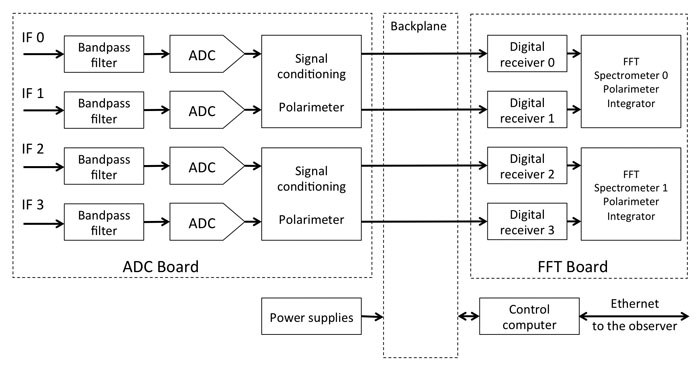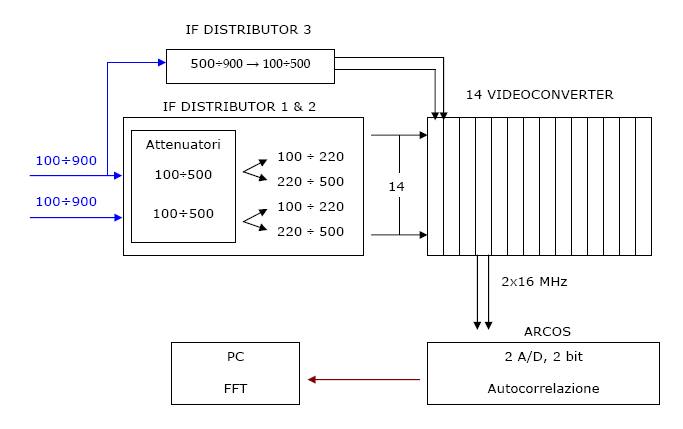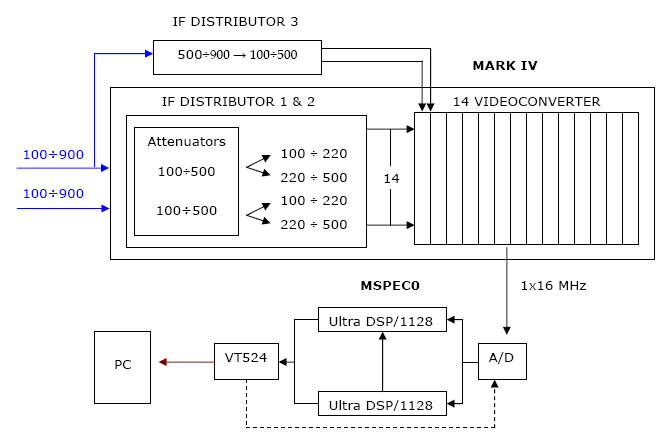|
|
8. Back End |
 |
|
|
8. Back End |
 |
8.1
Spectrometers
XARCOS is a digital spectro-polarimeter developed by
the Osservatorio Astrofisico di Arcetri staff, in
collaboration with Osservatorio Astronomico di Cagliari and
Istituto di Radioastronomia.
It is physically connected to the focus selector and possesses
8 inputs - thus being able to handle the 4 IFs of the
dual-feed receiver.
There are its main features:
- number of input lines: 8
- working band: 140-220 MHz
- frequency bins: 2048 per input
- instantaneous bandwidth: from 0.488 MHz to 125 MHz
- max effective spectral resolution: ~500 Hz (two
monochromatic lines are resolved when they differ of about ~1
kHz)
- integration time: multiples of 10 s
- output: spectra in Stokes parameters (I,Q,U,V)

Fig. 8.1 : 4-input scheme of the XARCOS board
NOTICE: this
device is not officially offered. Observers wanting to
exploit it are requested to contact us and receive
informations and proper assistance.
Arcos (ARcetri COrrelation Spectrometer) is a digital spectrometer developed by the Osservatorio di Arcetri. It is connected to the Mark IV and receives 2x16 MHz input from the videoconverters of the terminal.
The system could handle 2x20 MHz bands, anyway the Mark IV imposes 2x0.125 ÷ 16 MHz bands (2n steps)*
The main constituents are :
|
|
2 correlation boards (2048 channels in total) |
|
|
2 A/D sampler (4 channel sampler boards, 2 bit, 4 levels) |

Fig. 8.2 : ARCOS correlator scheme, example at 22 GHz (bands in MHz)
NOTICE: this device is
not officially offered. Observers wanting to exploit
it are requested to contact us and receive
informations and proper assistance.
This high-resolution digital spectrometer, installed in 1994, offers from 512 to 131072 channels (2n steps)* on a maximum bandwidth from 125 kHz to 16 MHz. Inside those ranges the resolution is user-defined. In the following table there are some examples :
|
Band |
Channels | Resolution |
| 0.125 kHz | 512 | 0.24 Hz |
| 1 MHz | 4096 | 244 Hz |
| 16 MHz | 131072 | 122 Hz |
Tab. 8.7 : Resolutions that can be obtained with Mspec0
The spectrometer receives 1 analog band from the Mark IV, digitizes it and applies an high efficiency FFT algorithm.
The main components are :
|
|
1 Ultra ADC A/D board |
|
|
1 VT-524 board |
|
|
2 UltraDSP/1128 board equipped with 2 LH9124 processors (VME environment) |
The processors run in parallel and operate the 24 bit, 256000 spectral points, Fourier transforms. The resulting spectra are integrated on the VT-524 board.
The DSP boards are completely programmable through the VME bus. The VT-524 board also allows the results to be shown in real time, as they are processed (the time required for the processing of a single spectrum is nearly 1 ms).
The spectrometer is TCP/IP connected to an external PC equipped with the "Spett" software, which supplies the user interface, in order to set the control system (channels number, sampling frequency, number of spectra to be averaged, number of On-Off cycles), and which is integrated in the "Field System" software for the antenna set up (pointing, observing frequencies, etc...).
The same PC is used to see the results during the observation.

Fig. 8.3 : Mspec0 scheme example at 22 GHz (bands in MHz)
* 0.125 MHz and 1 MHz band are available only with external filter, please ask if available at the site.
![]()